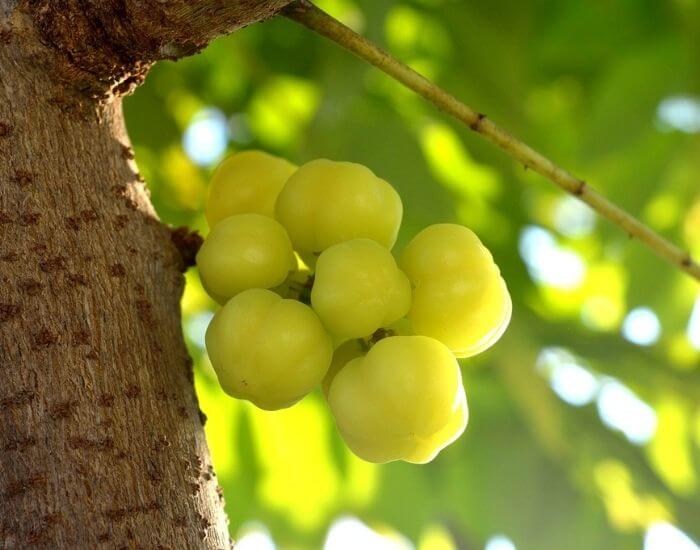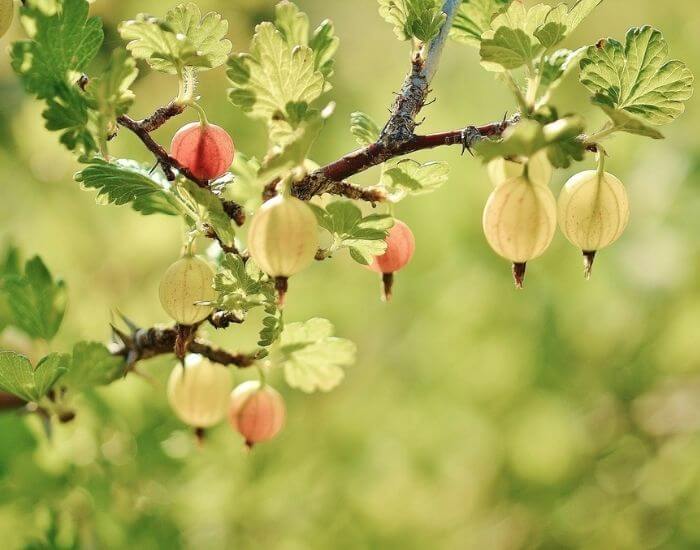What is the best grape variety you have ever tasted? Most people believe concord grapes are the sweetest. I was like most people until I tasted the mysterious jaboticaba fruit.
Native to Brazil, this small dark purple fruit is similar in appearance to a grape but with a thicker skin and larger seeds.
The fruit grows directly on the trunk and branches of the jaboticaba tree, making it a fascinating sight for those who have never seen it before.
If you want to learn more about this unique fruit, continue reading below. We’ll discuss its appearance, season, how to eat and more.
Jaboticaba Fruit varieties
There are several different varieties of jaboticaba available, each with their own unique characteristics. One of the most popular varieties is the Sabará jaboticaba, which produces small black fruits with a thin skin and sweet flesh.
Another variety is the Paulista jaboticaba, which produces larger fruits with thicker skins but still has a sweet flavor.
Another particularly interesting variety of jaboticaba is the branca. Vermelha. This type of tree produces bright green fruits .
Other varieties include rajada, roxa and Sao Paulo.
Jaboticaba fruit color
One of the most striking features of this fruit is its color. The skin of the jabuticaba fruit can range from deep purple to almost black, depending on the stage of ripeness.
When the fruit is young and still developing, it has a bright green color. As it matures, the skin darkens and becomes more uniform in color. When fully ripe, the skin is a shiny deep purple with a smooth texture.
Not only is the exterior of this fruit beautiful in color, but when you cut into it, you will find a translucent white flesh that surrounds one to four large seeds. Overall, it’s an attractive addition to any fruit basket or recipe.
How to tell if jabuticaba fruit is ripe
To determine if jabuticaba fruits are ripe, look for the color of their skin. When they are ready to be harvested, they will have a dark purple or almost black appearance. Additionally, mature fruits will come off easily from their stem when pulled gently.
Another way to check if it’s ripe is by its texture. The skin should feel smooth yet firm to the touch without any signs of bruising or blemishes. It should not feel too hard nor too soft.
Where does jaboticaba fruit come from?
The Brazilian grapetree can reach up to 45 feet in height and has an attractive, dark bark.
The tree is native to various regions of Brazil, primarily in the southeastern parts of the country. It thrives in tropical and subtropical climates with high levels of rainfall throughout the year.
In the United States, this fruit tree thrives in parts of California; especially Southern California. However, cultivators have noted trees in California are shorter and slow growing compared to trees in Brazil, Bolivia, and Uruguay. They are also shorter.
Nutrition Value
This delicious tropical fruit is low in calories but high in fiber and vitamin C. One cup of jaboticaba contains only 45 calories but provides 4 grams of dietary fiber.
Brazilian grapetree fruits also contain powerful antioxidants and are also rich in minerals like calcium, iron, and phosphorus. Additionally, they contain potassium.
When is jabuticaba fruit in season
Jaboticaba fruit, also known as the Brazilian grape tree, is a tropical fruit that grows in Brazil and other parts of South America. The fruit is small, purple-black in color with a thin skin and a soft white pulp. It has a sweet flavor that is often compared to grapes or blueberries.
The Jaboticaba fruit typically ripens from December to January in its native region of Brazil. However, it can also be found throughout the year due to different varieties and growing conditions. In some areas outside of Brazil where the climate is similar, such as Florida in the United States, Jaboticaba trees may produce two crops per year – one around May-June and another around November-December.
To determine if Jaboticaba fruits are in season near you, it’s important to research local growing conditions and talk to farmers or suppliers who specialize in tropical fruits. Additionally, keep an eye out for signs of ripeness such as a darker skin color and softer texture when gently squeezed.
Related Read: Learn about the lanzones fruit
Taste
The taste of this small fruit can be described as both sweet and slightly sour, with a texture similar to that of a grape. The fruit is also known for its distinct purple-black color, which makes it stand out among other fruits.
When ripe, its flesh has a soft texture and is slightly juicy. Some people describe it as having hints of grape, cranberry, or even lychee. Others compare it to blueberries or plums in terms of flavor.
Eating Brazilian grapetree fruit
One way of eating Jaboticaba fruit is by simply eating it fresh. The skin can be peeled off easily and the flesh inside can be consumed directly. This method is ideal for people who prefer a sweet and tangy taste.
Another way to eat Jaboticaba fruit is by making jams or jellies out of it. The berries are boiled with sugar until they become soft and pulpy, then strained through a sieve to remove any remaining seeds or skins. The resulting jam or jelly can be used as a spread on toast or added as a topping to desserts like ice cream or yogurt.
Jaboticaba Jam Recipe
Ingredients:
– 2 cups jaboticaba berries
– 1 cup sugar
– 1 tablespoon lemon juice
Instructions:
- Wash the jaboticaba berries and remove any stems.
- Place the berries in a pot and crush them slightly with a spoon.
- Add lemon and sugar
- Cook over medium heat, stirring occasionally, until the mixture thickens (around 20 minutes).
- Remove from heat (Cool)
- Transfer the jam into sterilized jars and refrigerate for later use or enjoy immediately on your favorite bread or toast.
Making drinks
One way to drink jaboticaba fruit is by making juice from the fresh berries. To do this, simply blend the berries with water and sugar until smooth, then strain the mixture through a cheesecloth or fine-mesh strainer.
Finally, jaboticaba fruit can also be used in cocktails and other adult beverages. Try muddling the berries with fresh mint leaves and lime juice for a refreshing summer cocktail, or adding them to sangria along with sliced oranges and lemons for an exotic twist on this classic drink.
Jabuticaba wine
Ingredients:
– 5 pounds of jabuticaba fruits
– 3 cups of sugar
– 1 packet of wine yeast
Instructions:
- Wash the jabuticaba fruits and remove any stems or leaves.
- Crush the fruits to release their juice, either by hand or using a blender.
- Transfer the crushed fruits into a large fermenting vessel.
- Add sugar to the vessel and mix well until dissolved.
- Sprinkle the wine yeast over the mixture and stir gently to combine.
- Cover the vessel with a clean cloth or plastic wrap and let it ferment for 7-10 days, stirring daily.
- After fermentation, strain the liquid through a fine mesh strainer to remove any solids.
- Pour the strained liquid into sterilized bottles and seal them tightly.
- Store the bottles in a cool, dark place for at least 3 months to allow the wine to mature before enjoying.
Storage
Firstly, it is important to store Jaboticaba fruit in the refrigerator as soon as possible after picking or purchasing. The ideal temperature for storing Jaboticaba fruit is between 45-50°F (7-10°C). This will help to preserve its freshness and flavor for up to three weeks.
Secondly, it is best to store Jaboticaba fruit in an airtight container or plastic bag. This will prevent moisture from getting inside the container and causing the fruit to spoil more quickly.
Finally, it is also possible to freeze jaboticaba fruit for later use. To do this, simply wash the berries thoroughly and remove any stems or leaves
Then place them in an airtight freezer bag or container and freeze until ready to use. Frozen Jaboticaba can be used in smoothies, jams, or other recipes that call for fresh berries.
Where to buy
Where to buy jaboticaba? If you’re interested in trying this small berry, there are a few places where you can find it.
Firstly, if you live in Brazil or nearby countries such as Argentina, Peru, and Uruguay, you should be able to find it at local markets and grocery stores.
These fruits are commonly grown throughout the region and are readily available all year round. In California, these fruits are available in summer.
If you live outside of South America, your best bet for finding jaboticaba may be specialty food stores or online retailers that specialize in exotic fruits.
In addition to fresh fruit, many companies sell jaboticaba products such as jams and wines. These items can usually be found at gourmet food shops or online retailers that specialize in unique culinary products.
Can you grow jaboticaba fruit in florida?
Can you grow jaboticaba fruit in Florida? The answer is yes! Jaboticaba trees have been successfully grown in Florida’s subtropical climate, especially in areas such as Miami-Dade County.
However, before planting the tree, consider some factors such as soil type and drainage. The ideal soil for growing jaboticaba should be well-drained loam with high organic matter content.
The timing of the planting can also affect the growth of your jaboticaba tree. It is best to plant them during warm weather when temperatures are consistently above 60°F.
Proper care must also be given to your plant so it can grow healthy and bear fruits regularly. With proper maintenance and care, you can easily cultivate this exotic fruit right in your own backyard in Florida!
What is the lifespan of a jaboticaba tree?
The brazilian grapetree is a slow-growing evergreen that can live for up to 150 years. It is native to Brazil but has spread throughout South America and other tropical regions of the world. The tree can reach up to 45 feet in height, but it usually grows to be around 20-30 feet tall.
How long does it take jaboticaba tree to fruit?
In terms of fruit production, a grafted jaboticaba tree starts bearing fruit at around five years old while a seed-grown tree can take between 10-20 years to fruit.
While the lifespan of a jaboticaba tree may seem impressive, it is important to note that factors such as disease, pests, and environmental conditions can impact its longevity.
Proper care and maintenance are crucial for ensuring that your jaboticaba tree lives a long and healthy life while providing you with delicious fruit year after year.
Final Thoughts:
Jabuticaba fruits are a unique and delicious addition to any diet. With their versatility in culinary applications, from jams and jellies to wines and liqueurs, these small fruits offer endless possibilities for experimentation in the kitchen.
The tree’s ornamental qualities also make it an attractive addition to gardens and landscapes. So why not give this exotic Brazilian fruit a try? Incorporate jabuticaba into your diet and reap its numerous benefits while enjoying its delightful flavor.
sources;
Hi There,
My name is Jenny. I’m the Chief Editor at Try Green Recipes and besides making yummy and healthy foods for my kids, grandkids, and friends. I’m new to the blogging world but I believe what I have to share is unique and will bring joy to your home. If you are adventurous and want try something tasty, let’s get started.

